Model-Based Cost Optimization of Double-Effect Water-Lithium Bromide Absorption Refrigeration Systems
Abstract
:1. Introduction
2. Process Description
3. Mathematical Model
Optimization Problem: Total Annual Cost (TAC) Minimization
4. Results and Discussion
- –
- High temperature generator (HTG): saturated steam at 160 °C.
- –
- Absorber (ABS) and condenser (COND): cooling water at 20 °C.
- –
- Evaporator (EVAP): Inlet and outlet chilled water temperatures: 13.0 °C and 10.0 °C, respectively; evaporator working temperature: 4.0 °C.
Influence of the Solution Heat Exchangers on the Optimal Solutions
5. Conclusions
Supplementary Materials
Author Contributions
Funding
Acknowledgments
Conflicts of Interest
References
- Garousi Farshi, L.; Mahmoudi, S.M.S.; Rosen, M.A.; Yari, M.; Amidpour, M. Exergoeconomic analysis of double effect absorption refrigeration systems. Energy Convers. Manag. 2013, 65, 13–25. [Google Scholar] [CrossRef]
- Mazzei, M.S.; Mussati, M.C.; Mussati, S.F. NLP model-based optimal design of LiBr–H2O absorption refrigeration systems. Int. J. Refrig. 2014, 38, 58–70. [Google Scholar] [CrossRef]
- Kaynakli, O.; Kilic, M. Theoretical study on the effect of operating conditions on performance of absorption refrigeration system. Energy Convers. Manag. 2007, 48, 599–607. [Google Scholar] [CrossRef]
- Avanessian, T.; Ameri, M. Energy, exergy, and economic analysis of single and double effect LiBr–H2O absorption chillers. Energy Build. 2014, 73, 26–36. [Google Scholar] [CrossRef]
- Mussati, S.F.; Gernaey, K.V.; Morosuk, T.; Mussati, M.C. NLP modeling for the optimization of LiBr-H2O absorption refrigeration systems with exergy loss rate, heat transfer area, and cost as single objective functions. Energy Convers. Manag. 2016, 127, 526–544. [Google Scholar] [CrossRef]
- Talbi, M.M.; Agnew, B. Exergy analysis: An absorption refrigerator using lithium bromide and water as the working fluids. Appl. Therm. Eng. 2000, 20, 619–630. [Google Scholar] [CrossRef]
- Misra, R.D.; Sahoo, P.K.; Sahoo, S.; Gupta, A. Thermoeconomic optimization of a single effect water/LiBr vapour absorption refrigeration system. Int. J. Refrig. 2003, 26, 158–169. [Google Scholar] [CrossRef]
- Kızılkan, Ö.; Şencan, A.; Kalogirou, S.A. Thermoeconomic optimization of a LiBr absorption refrigeration system. Chem. Eng. Process. Process Intensif. 2007, 46, 1376–1384. [Google Scholar] [CrossRef]
- Rubio-Maya, C.; Pacheco-Ibarra, J.J.; Belman-Flores, J.M.; Galván-González, S.R.; Mendoza-Covarrubias, C. NLP model of a LiBr–H2O absorption refrigeration system for the minimization of the annual operating cost. Appl. Therm. Eng. 2012, 37, 10–18. [Google Scholar] [CrossRef]
- Srikhirin, P.; Aphornratana, S.; Chungpaibulpatana, S. A review of absorption refrigeration technologies. Renew. Sustain. Energy Rev. 2001, 5, 343–372. [Google Scholar] [CrossRef]
- Garousi, F.; Seyed, M.; Rosen, M.A.; Yari, M. A comparative study of the performance characteristics of double-effect absorption refrigeration systems. Int. J. Energy Res. 2012, 36, 182–192. [Google Scholar] [CrossRef]
- Garousi Farshi, L.; Seyed Mahmoudi, S.M.; Rosen, M.A. Analysis of crystallization risk in double effect absorption refrigeration systems. Appl. Therm. Eng. 2011, 31, 1712–1717. [Google Scholar] [CrossRef]
- Arun, M.B.; Maiya, M.P.; Murthy, S.S. Performance comparison of double-effect parallel-flow and series flow water–lithium bromide absorption systems. Appl. Therm. Eng. 2001, 21, 1273–1279. [Google Scholar] [CrossRef]
- Kaushik, S.C.; Arora, A. Energy and exergy analysis of single effect and series flow double effect water–lithium bromide absorption refrigeration systems. Int. J. Refrig. 2009, 32, 1247–1258. [Google Scholar] [CrossRef]
- Kaynakli, O.; Saka, K.; Kaynakli, F. Energy and exergy analysis of a double effect absorption refrigeration system based on different heat sources. Energy Convers. Manag. 2015, 106, 21–30. [Google Scholar] [CrossRef]
- Talukdar, K.; Gogoi, T.K. Exergy analysis of a combined vapor power cycle and boiler flue gas driven double effect water–LiBr absorption refrigeration system. Energy Convers. Manag. 2016, 108, 468–477. [Google Scholar] [CrossRef]
- Misra, R.D.; Sahoo, P.K.; Gupta, A. Thermoeconomic evaluation and optimization of a double-effect H2O/LiBr vapour-absorption refrigeration system. Int. J. Refrig. 2005, 28, 331–343. [Google Scholar] [CrossRef]
- Bereche, R.P.; Palomino, R.G.; Nebra, S.A. Thermoeconomic analysis of a single and double-effect LiBr/H2O absorption refrigeration system. Int. J. Thermodyn. 2009, 12, 89–96. [Google Scholar]
- Gebreslassie, B.H.; Medrano, M.; Boer, D. Exergy analysis of multi-effect water–LiBr absorption systems: From half to triple effect. Renew. Energy 2010, 35, 1773–1782. [Google Scholar] [CrossRef]
- Mussati, S.F.; Aguirre, P.A.; Scenna, N.J. Novel Configuration for a Multistage Flash-Mixer Desalination System. Ind. Eng. Chem. Res. 2003, 42, 4828–4839. [Google Scholar] [CrossRef]
- Alasino, N.; Mussati, M.C.; Scenna, N.J.; Aguirre, P. Wastewater treatment plant synthesis and design: Combined biological nitrogen and phosphorus removal. Ind. Eng. Chem. Res. 2010, 49, 8601–8612. [Google Scholar] [CrossRef]
- Oliva, D.G.; Francesconi, J.A.; Mussati, M.C.; Aguirre, P.A. Energy efficiency analysis of an integrated glycerin processor for PEM fuel cells: Comparison with an ethanol-based system. Int. J. Hydrogen Energy 2010, 35, 709–724. [Google Scholar] [CrossRef]
- Oliva, D.G.; Francesconi, J.A.; Mussati, M.C.; Aguirre, P.A. Modeling, synthesis and optimization of heat exchanger networks. Application to fuel processing systems for PEM fuel cells. Int. J. Hydrogen Energy 2011, 36, 9098–9114. [Google Scholar] [CrossRef]
- Arias, A.M.; Mussati, M.C.; Mores, P.L.; Scenna, N.J.; Caballero, J.A.; Mussati, S.F. Optimization of multi-stage membrane systems for CO2 capture from flue gas. Int. J. Greenh. Gas Control 2016, 53, 371–390. [Google Scholar] [CrossRef]
- Manassaldi, J.I.; Arias, A.M.; Scenna, N.J.; Mussati, M.C.; Mussati, S.F. A discrete and continuous mathematical model for the optimal synthesis and design of dual pressure heat recovery steam generators coupled to two steam turbines. Energy 2016, 103, 807–823. [Google Scholar] [CrossRef]
- Gebreslassie, B.H.; Guillén-Gosálbez, G.; Jiménez, L.; Boer, D. Design of environmentally conscious absorption cooling systems via multi-objective optimization and life cycle assessment. Appl. Energy 2009, 86, 1712–1722. [Google Scholar] [CrossRef]
- Chahartaghi, M.; Golmohammadi, H.; Shojaei, A. Performance analysis and optimization of new double effect lithium bromide–water absorption chiller with series and parallel flows. Int. J. Refrig. 2019, 97, 73–87. [Google Scholar] [CrossRef]
- Lee, S.; Lee, J.; Lee, H.; Chung, J.; Kang, Y. Optimal design of generators for H2O/LiBr absorption chiller with multi-heat sources. Energy 2019, 167, 47–59. [Google Scholar] [CrossRef]
- Sabbagh, A.; Gómez, J. Optimal control of single stage LiBr/water absorption chiller. Int. J. Refrig. 2018, 1–9. [Google Scholar] [CrossRef]
- Lubis, A.; Jeong, J.; Giannetti, N.; Yamaguchi, S.; Saito, K.; Yabase, H.; Alhamid, M.I.; Nasruddin. Operation performance enhancement of single-double-effect absorption chiller. Appl. Energy 2018, 219, 299–311. [Google Scholar] [CrossRef]
- Kawajir, Y.; Laird, C.; Wachter, A. Introduction to Ipopt: A Tutorial for Downloading, Installing, and Using Ipopt, 2087 ed. 2012. Available online: https://projects.coin-or.org/Ipopt (accessed on 23 November 2018).
- Mussati, S.F.; Cignitti, S.; Mansouri, S.S.; Gernaey, K.V.; Morosuk, T.; Mussati, M.C. Configuration optimization of series flow double-effect water-lithium bromide absorption refrigeration systems by cost minimization. Energy Convers. Manag. 2018, 158, 359–372. [Google Scholar] [CrossRef]
- Udugama, I.A.; Mansouri, S.S.; Mitic, A.; Flores-Alsina, X.; Gernaey, K.V. Perspectives on Resource Recovery from Bio-Based Production Processes: From Concept to Implementation. Processes 2017, 5, 48. [Google Scholar] [CrossRef]
- Mansouri, S.S.; Udugama, I.A.; Cignitti, S.; Mitic, A.; Flores-Alsina, X.; Gernaey, K.V. Resource recovery from bio-based production processes: A future necessity? Curr. Opin. Chem. Eng. 2017, 18, 1–9. [Google Scholar] [CrossRef]
- Dincer, I. Refrigeration Systems and Applications; Wiley: Hoboken, NJ, USA, 2003; ISBN 978-0-471-62351-9. [Google Scholar]
- American Society of Heating, Refrigerating and Air-Conditioning Engineers. 1989 ASHRAE Handbook: Fundamentals; ASHRAE: Atlanta, GA, USA, 1989; ISBN 978-0-910110-57-0. [Google Scholar]
- Gilani, S.I.-u.-H.; Ahmed, M.S.M.S. Solution crystallization detection for double-effect LiBr-H2O steam absorption chiller. Energy Procedia 2015, 75, 1522–1528. [Google Scholar] [CrossRef]
- GAMS Development Corporation. General Algebraic Modeling System (GAMS) Release 23.6.5; GAMS Development Corporation: Washington, DC, USA, 2010. [Google Scholar]
- Drud, A. CONOPT 3 Solver Manual; ARKI Consulting and Development A/S: Bagsvaerd, Denmark, 2012. [Google Scholar]
- Khan, M.; Tahan, S.; El-Achkar, M.; Jamus, S. The study of operating an air conditioning system using Maisotsenko-Cycle. Mater. Sci. Eng. 2018, 323, 1–7. [Google Scholar] [CrossRef]
- Union Gas Limited. Calculating the True Cost of Steam. Available online: http://members.questline.com/Article.aspx?articleID=18180&accountID=1863&nl=13848 (accessed on 23 November 2018).
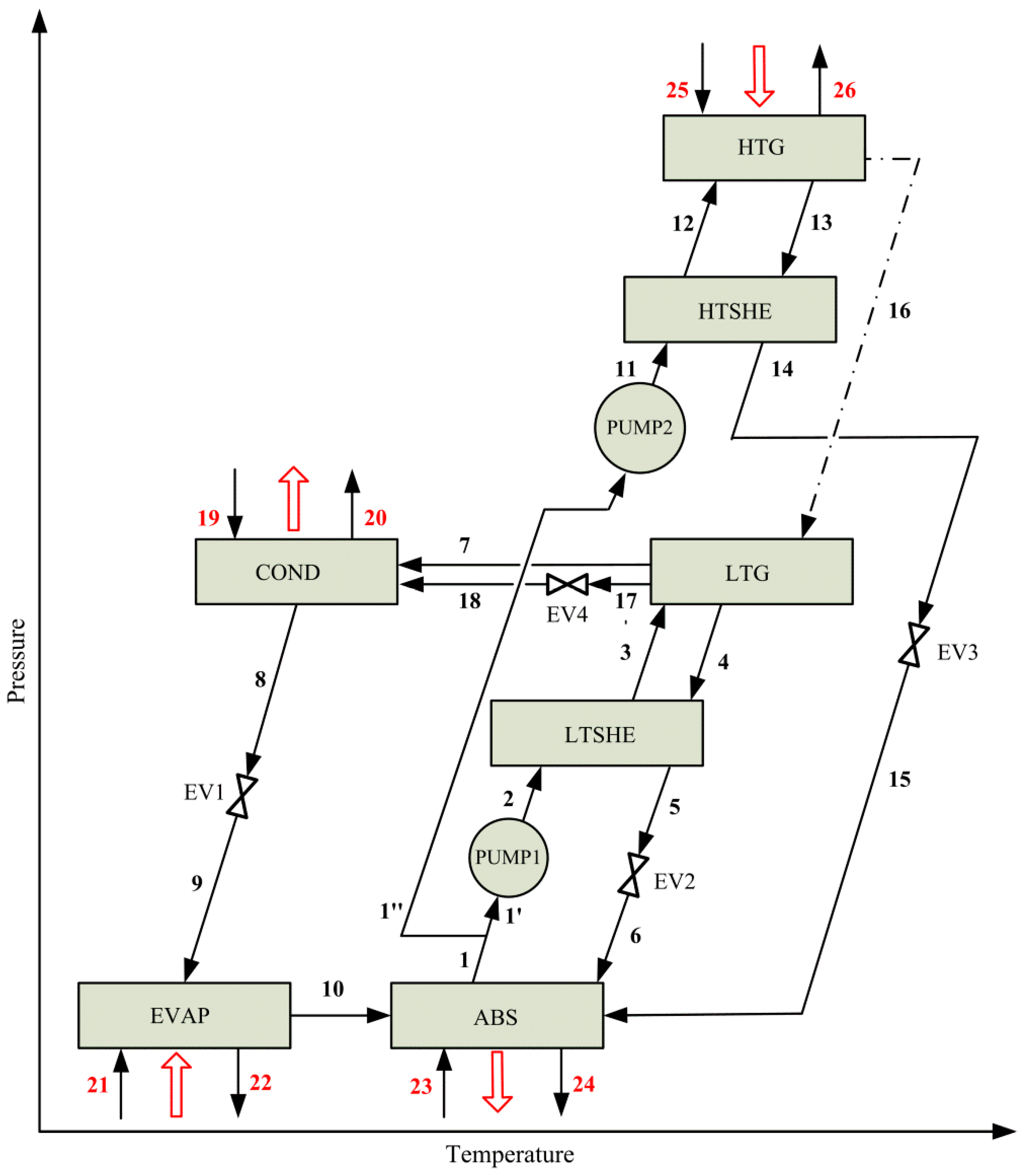
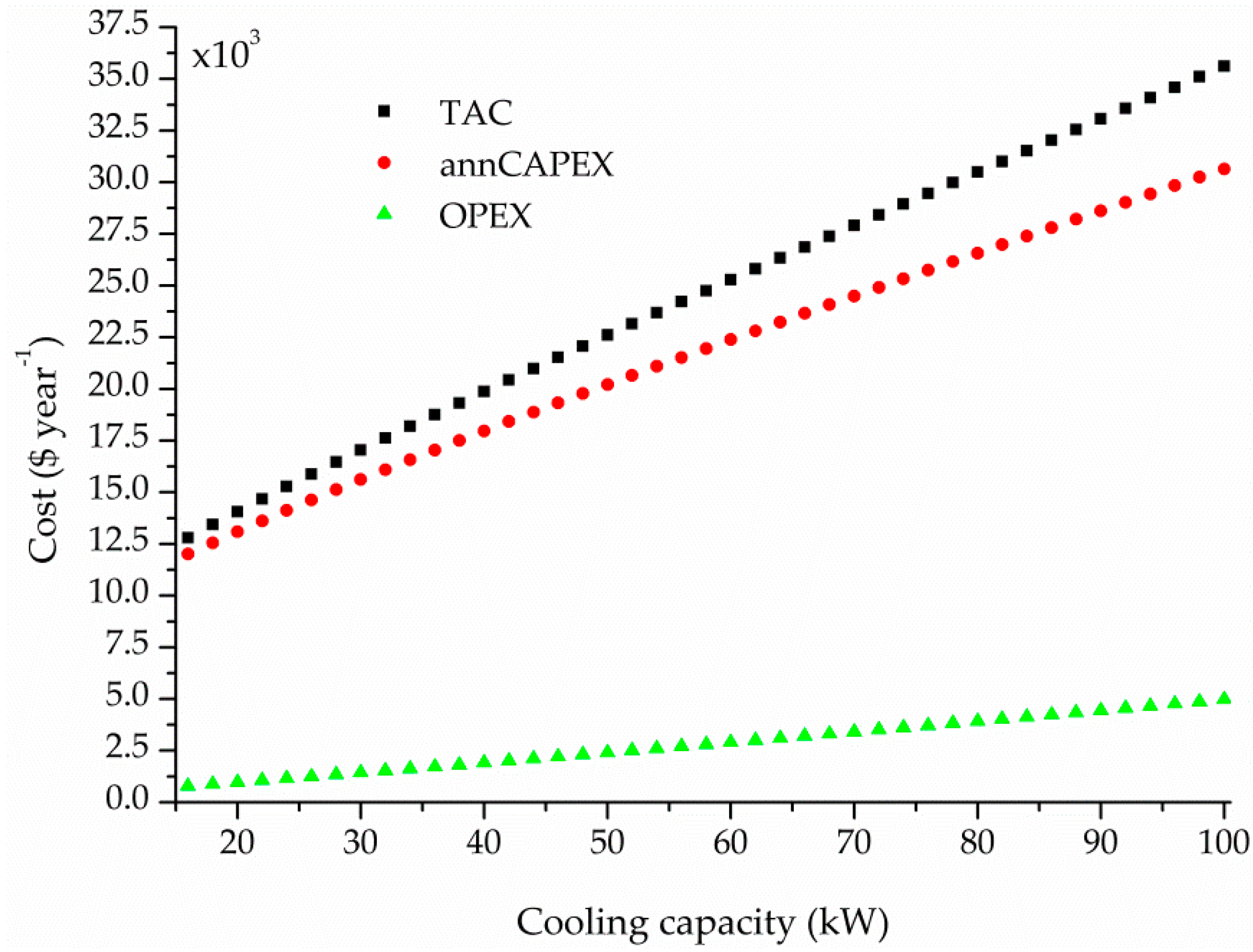
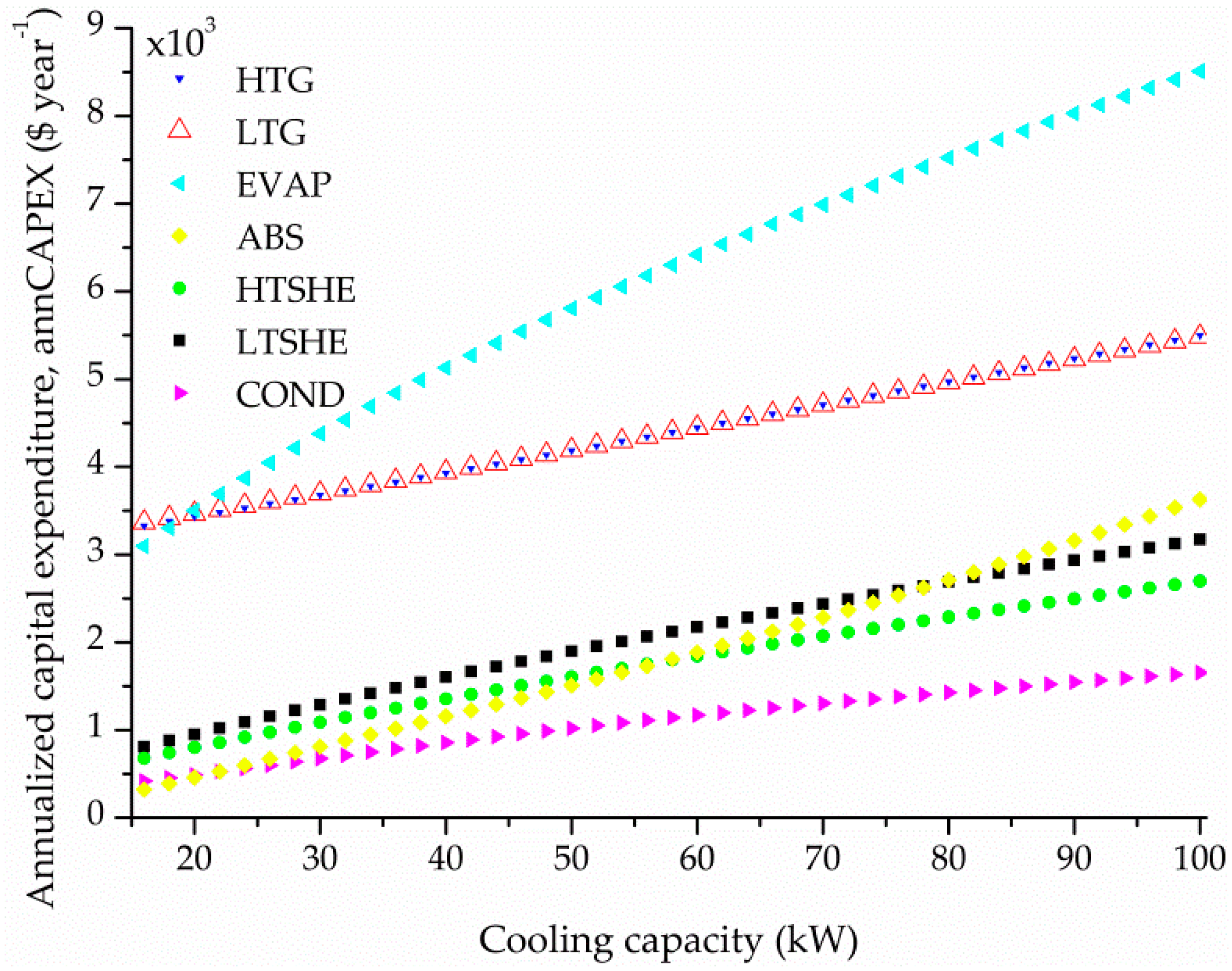

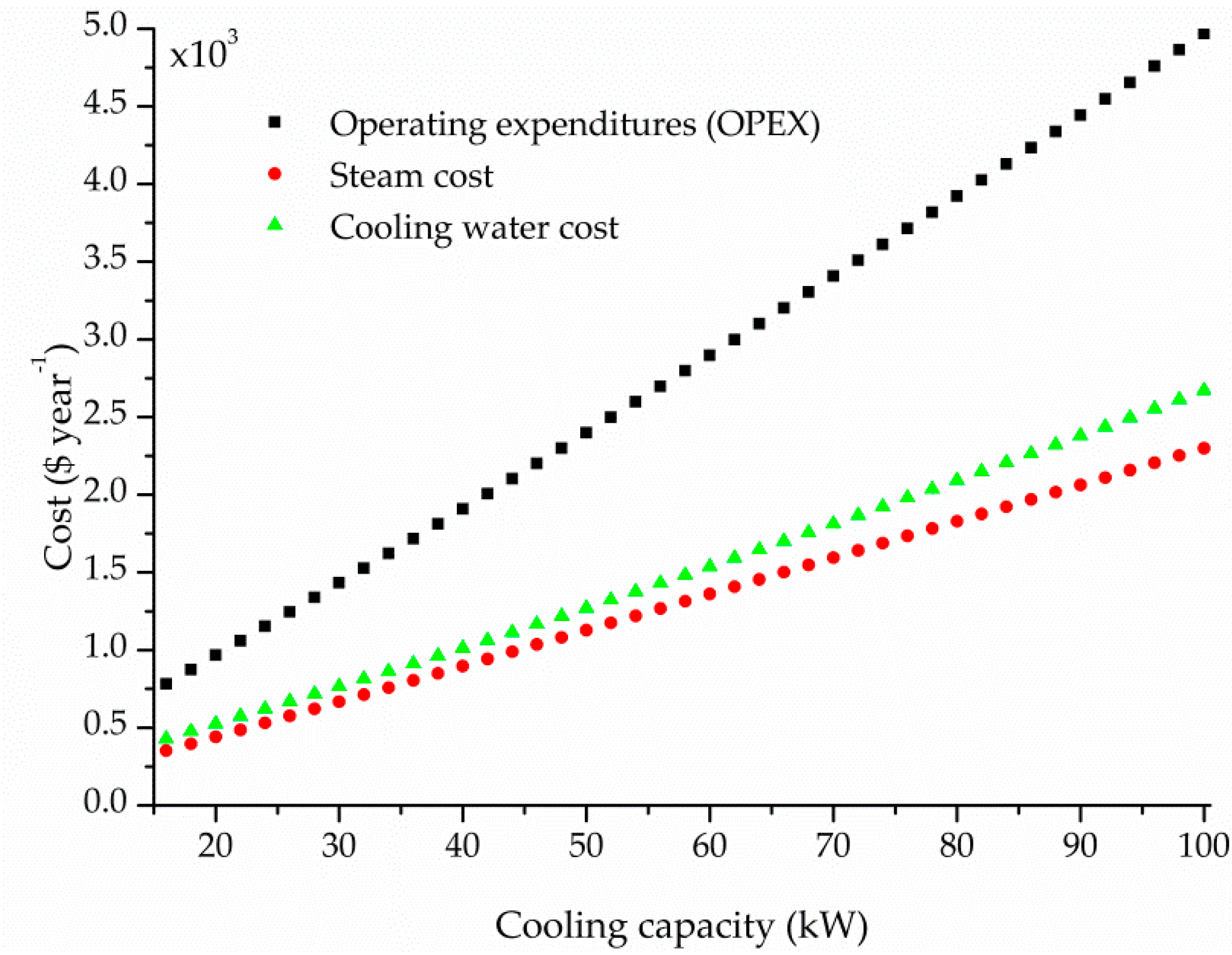
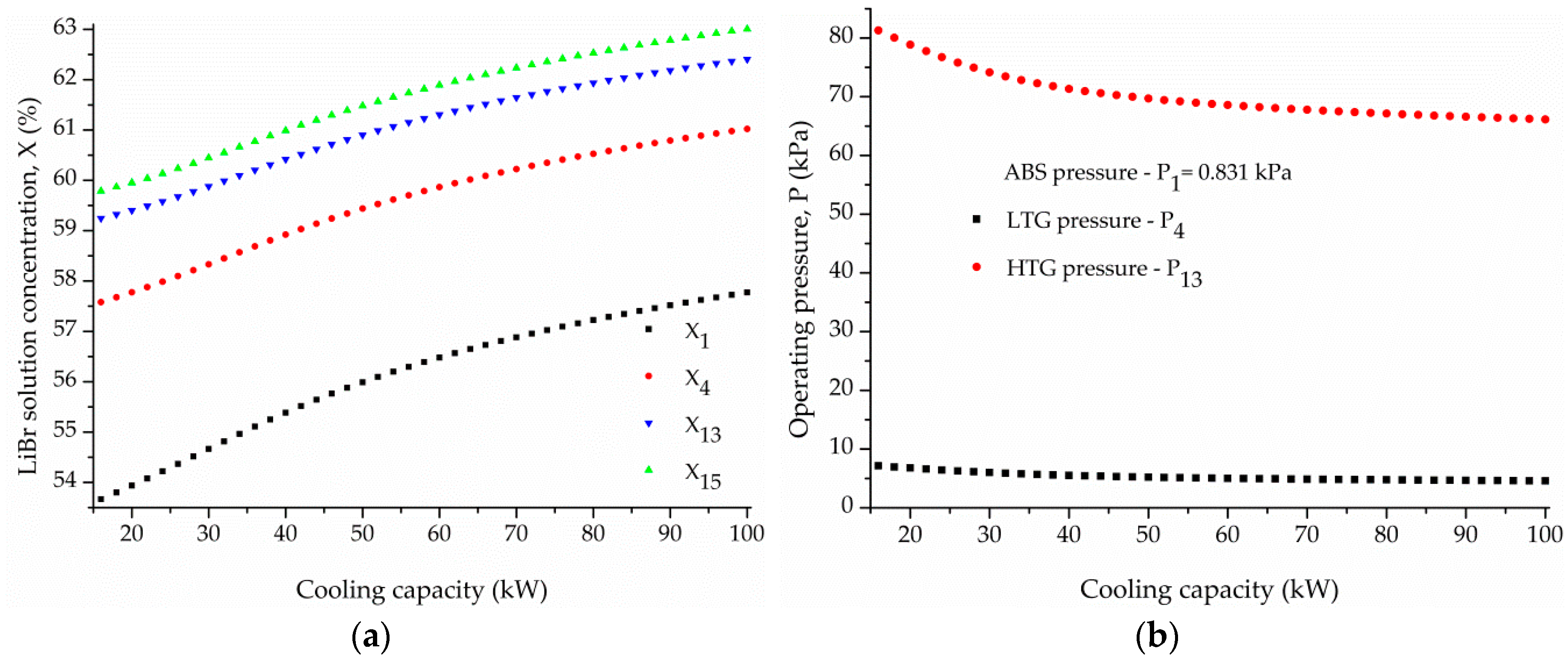
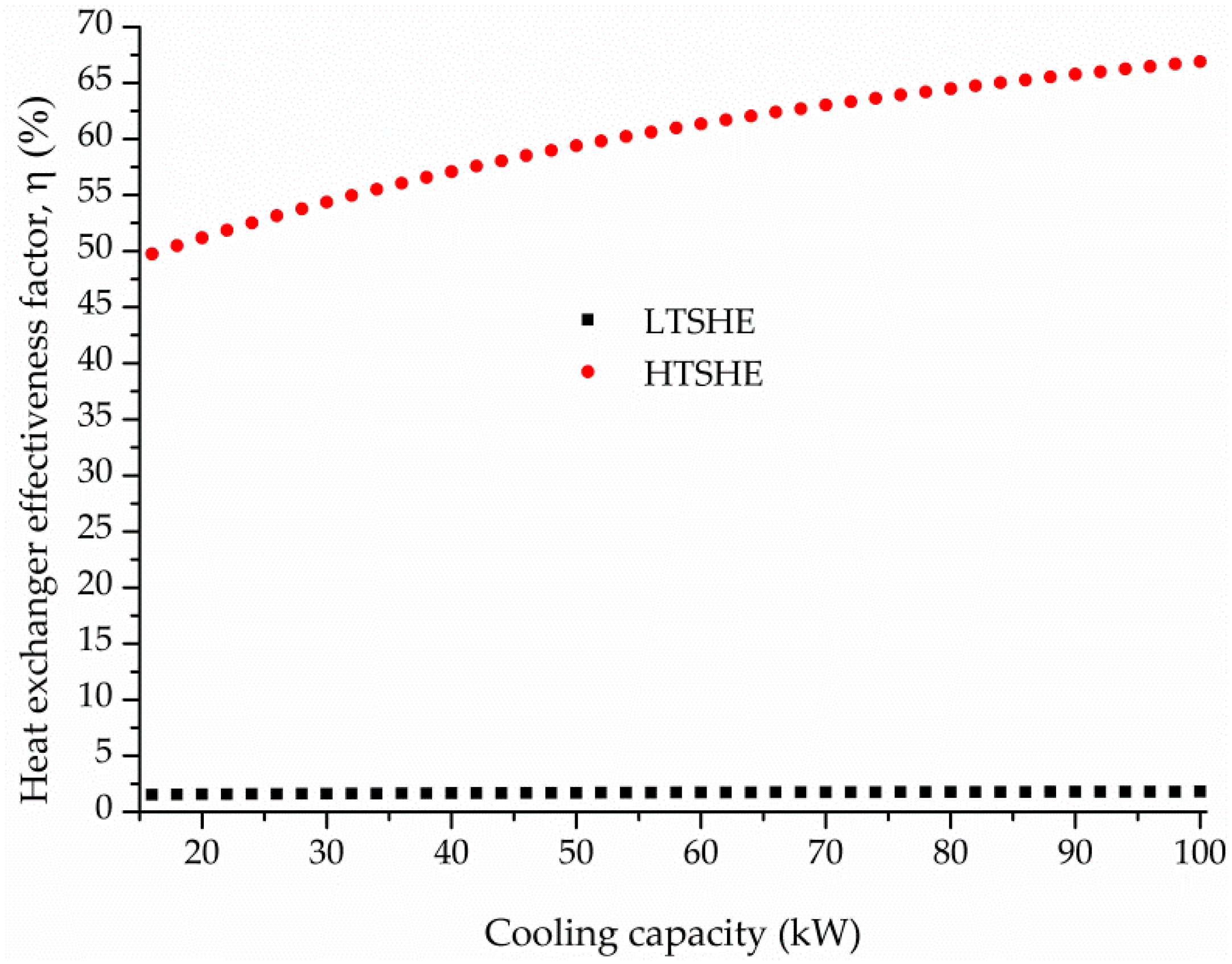
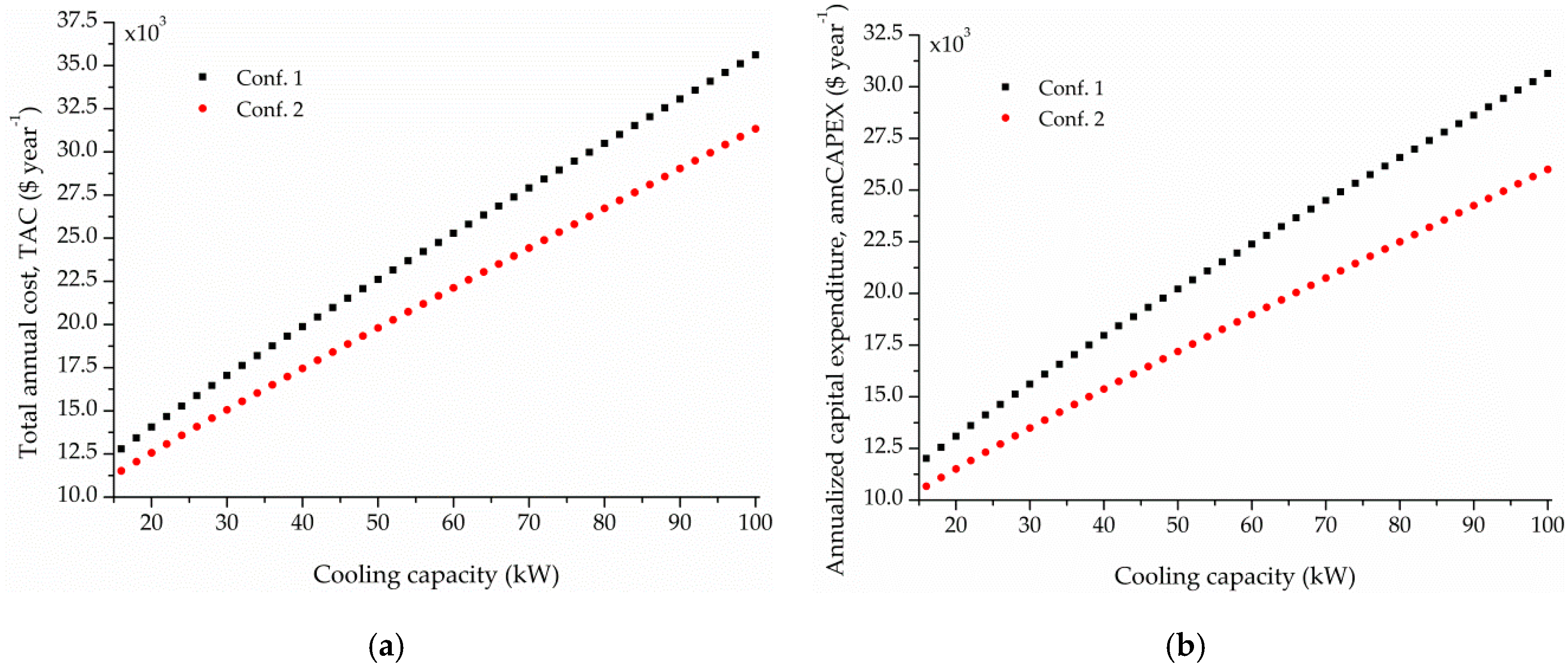
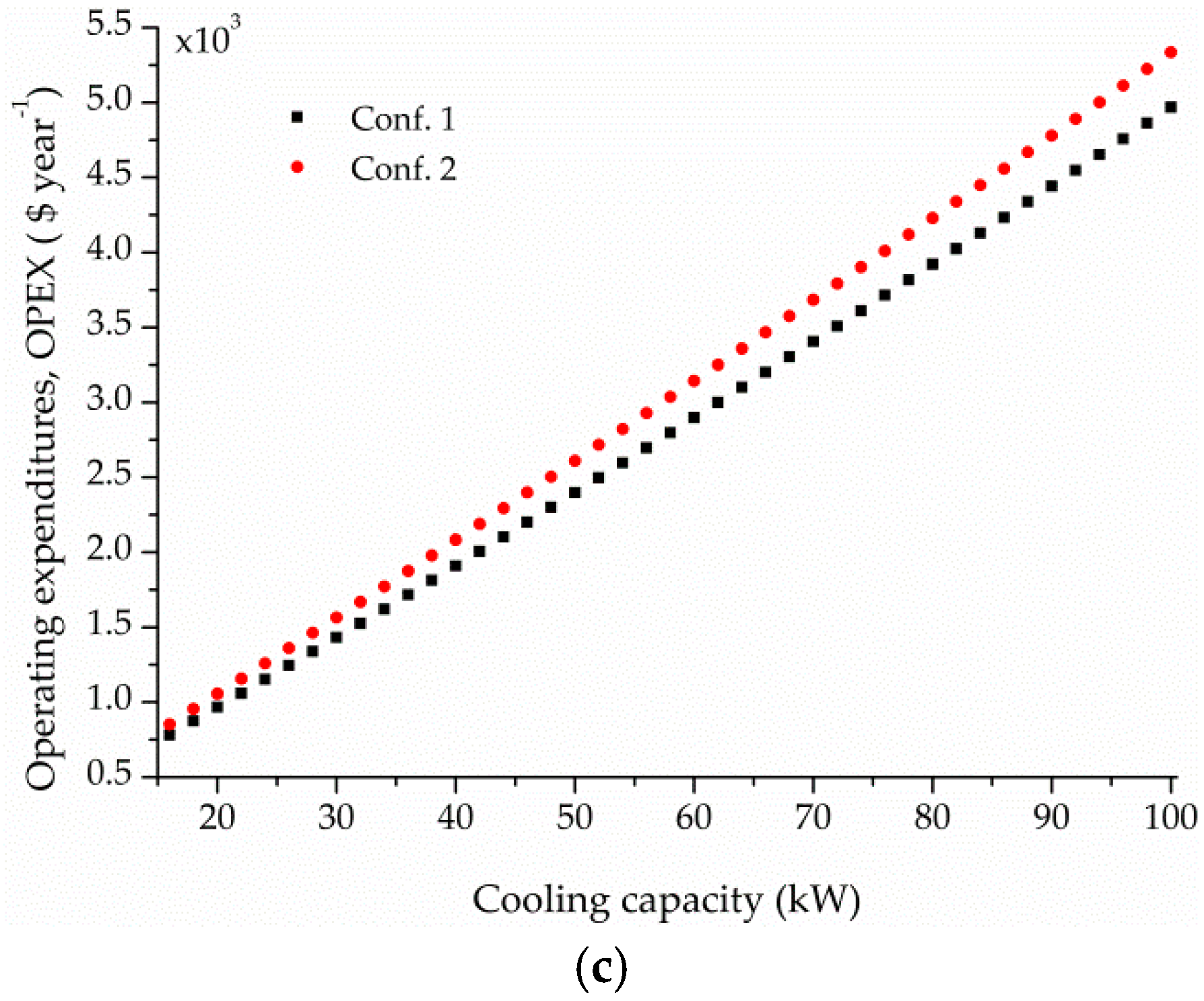
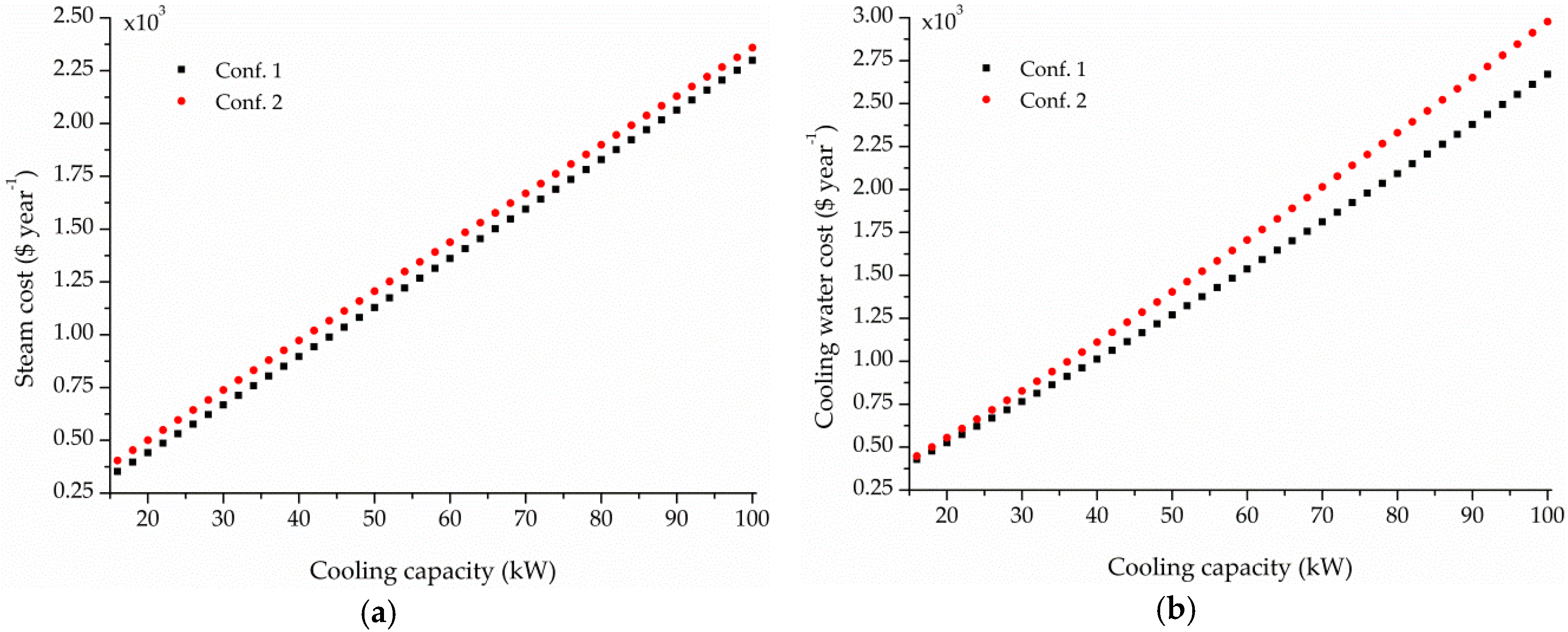
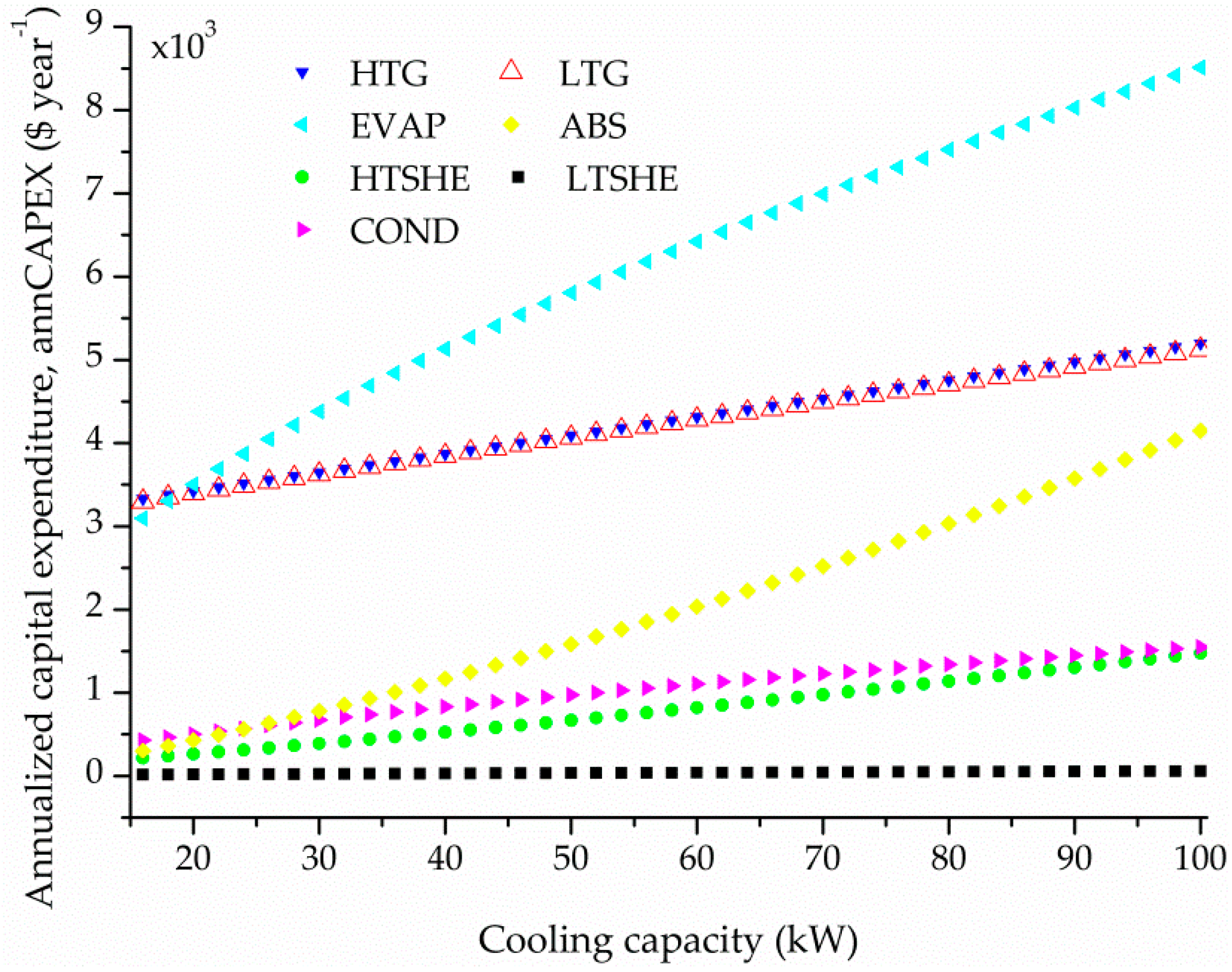
| Cost Item | Conf. 1 | Conf. 2 | Deviation (%) |
|---|---|---|---|
| TAC (M$·year−1) | 12,794.5 | 11,537.2 | −9.8 |
| annCAPEX (M$·year−1) | 12,013.6 | 10,684.3 | −11.1 |
| CAPEX (M$) | 106,315.5 | 94,551.5 | −11.1 |
| EVAP | 27,384.7 | 27,384.7 | 0 |
| HTG | 29,794.7 | 29,470.8 | −1.1 |
| LTG | 29,447.1 | 29,195.3 | −0.9 |
| COND | 3701.9 | 3802.2 | +2.7 |
| LTSHE | 7135.8 | 121.2 (*) | − |
| HTSHE | 5997.4 | 1911.9 | −68.1 |
| ABS | 2853.9 | 2665.6 | −6.6 |
| OPEX (M$·year−1) | 780.8 | 852.9 | +9.2 |
| Steam | 352.6 | 405.0 | +14.9 |
| Cooling water | 428.2 | 447.9 | +4.6 |
| Heat Load (kW) | Heat Transfer Area (m2) | Driving Force (°C) | ||||
|---|---|---|---|---|---|---|
| Conf. 1 | Conf. 2 | Conf. 1 | Conf. 2 | Conf. 1 | Conf. 2 | |
| EVAP | 16.000 | 16.000 | 1.443 | 1.443 | 7.393 | 7.393 |
| HTG | 12.029 | 13.816 | 0.313 | 0.287 | 25.633 | 32.144 |
| LTG | 9.056 | 10.030 | 0.285 | 0.265 | 20.525 | 24.462 |
| COND1 | 0.223 | 0.202 | 0.004 | 0.004 | 23.486 | 21.981 |
| COND2 | 7.302 | 6.409 | 0.220 | 0.235 | 13.674 | 11.251 |
| LTSHE | 3.378 η = 75% | 0.047 η = 1.521 | 0.356 | 0.001 | 9.484 | 44.725 |
| HTSHE | 7.375 η = 75% | 3.197 η = 49.767 | 0.278 | 0.054 | 26.544 | 58.918 |
| ABS | 20.503 | 23.205 | 2.074 | 1.997 | 9.888 | 11.619 |
| Pressure (kPa) | Temperature (°C) | Solution Conc. (kg LiBr kg−1 sol.) × 100 | Mass Flow Rate (kg·s−1) | |||||
|---|---|---|---|---|---|---|---|---|
| Point | Conf. 1 | Conf. 2 | Conf. 1 | Conf. 2 | Conf. 1 | Conf. 2 | Conf. 1 | Conf. 2 |
| 1 | 0.813 | 0.813 | 30.944 | 30.967 | 53.668 | 53.681 | 0.085 | 0.058 |
| 2 | 7.150 | 5.835 | 30.944 | 30.967 | 53.668 | 53.681 | 0.045 | 0.032 |
| 3 | 7.150 | 5.835 | 66.918 | 31.659 | 53.668 | 53.681 | 0.045 | 0.032 |
| 4 | 7.150 | 5.835 | 78.910 | 76.438 | 57.578 | 58.449 | 0.042 | 0.030 |
| 5 | 7.150 | 5.835 | 38.298 | 75.638 | 57.578 | 58.449 | 0.042 | 0.030 |
| 6 | 0.813 | 0.813 | 38.198 | 42.666 | 57.582 | 59.863 | 0.042 | 0.030 |
| 7 | 7.150 | 5.835 | 78.910 | 76.438 | − | − | 0.003 | 0.003 |
| 8 | 7.150 | 5.835 | 39.345 | 35.595 | − | − | 0.007 | 0.007 |
| 9 | 0.813 | 0.813 | 4.005 | 4.005 | − | − | 0.007 | 0.007 |
| 10 | 0.813 | 0.813 | 4.005 | 4.005 | − | − | 0.007 | 0.007 |
| 11 | 81.299 | 58.161 | 30.944 | 30.967 | 53.668 | 53.681 | 0.040 | 0.026 |
| 12 | 81.299 | 58.161 | 117.292 | 89.468 | 53.668 | 53.681 | 0.040 | 0.026 |
| 13 | 81.299 | 58.161 | 146.074 | 148.517 | 59.245 | 63.889 | 0.037 | 0.022 |
| 14 | 81.299 | 58.161 | 55.368 | 89.756 | 59.245 | 63.889 | 0.037 | 0.022 |
| 15 | 0.813 | 0.813 | 42.516 | 53.893 | 59.787 | 65.401 | 0.037 | 0.022 |
| 16 | 81.299 | 58.161 | 146.074 | 148.517 | − | − | 0.004 | 0.004 |
| 17 | 81.299 | 58.161 | 94.023 | 85.209 | − | − | 0.004 | 0.004 |
| 18 | 7.150 | 5.835 | 39.345 | 35.595 | − | − | 0.004 | 0.004 |
| Cost Item | Conf. 1 | Conf. 2 | Deviation (%) |
|---|---|---|---|
| TAC (M$·year−1) | 35,613.9 | 31,338.1 | −12.0 |
| annCAPEX (M$·year−1) | 30,644.4 | 26,001.7 | −15.1 |
| CAPEX (M$) | 271,189.7 | 230,103.8 | −15.1 |
| EVAP | 75,306.6 | 75,306.6 | 0 |
| HTG | 48,532.7 | 45,984.3 | −5.3 |
| LTG | 48,642.3 | 45,325.2 | −6.8 |
| COND | 14,649.4 | 13,715.8 | −6.4 |
| LTSHE | 28,054.3 | 514.0 (*) | − |
| HTSHE | 23,875.4 | 13,062.0 | −45.3 |
| ABS | 32,128.8 | 36,709.9 | +14.3 |
| OPEX (M$·year−1) | 4969.5 | 5336.4 | +7.4 |
| Steam | 2298.9 | 2358.8 | +2.6 |
| Cooling water | 2670.6 | 2977.6 | +11.5 |
| Heat Load (kW) | Heat Transfer Area (m2) | Driving Force (°C) | ||||
|---|---|---|---|---|---|---|
| Conf. 1 | Conf. 2 | Conf. 1 | Conf. 2 | Conf. 1 | Conf. 2 | |
| EVAP | 100.00 | 100.00 | 9.017 | 9.017 | 7.393 | 7.393 |
| HTG | 78.424 | 80.466 | 2.295 | 1.988 | 22.781 | 26.979 |
| LTG | 56.767 | 61.849 | 2.308 | 1.911 | 15.866 | 20.885 |
| COND1 | 1.582 | 1.389 | 0.049 | 0.039 | 12.977 | 14.307 |
| COND2 | 45.018 | 40.332 | 3.602 | 3.189 | 5.175 | 5.233 |
| LTSHE | 20.039 (η = 75%) | 0.316 (η = 1.794%) | 2.518 | 0.008 | 7.960 | 38.000 |
| HTSHE | 52.188 (η = 75%) | 29.361 (η = 66.910%) | 1.999 | 0.845 | 26.101 | 34.758 |
| ABS | 131.825 | 138.745 | 7.842 | 8.438 | 16.809 | 16.442 |
| Pressure (kPa) | Temperature (°C) | Solution Conc. (kg LiBr kg−1 sol.) × 100 | Mass Flow Rate (kg·s−1) | |||||
|---|---|---|---|---|---|---|---|---|
| Point | Conf. 1 | Conf. 2 | Conf. 1 | Conf. 2 | Conf. 1 | Conf. 2 | Conf. 1 | Conf. 2 |
| 1 | 0.813 | 0.813 | 38.569 | 35.667 | 57.774 | 56.253 | 0.667 | 0.416 |
| 2 | 4.575 | 4.146 | 38.569 | 35.667 | 57.774 | 56.253 | 0.349 | 0.223 |
| 3 | 4.575 | 4.146 | 67.385 | 36.162 | 57.774 | 56.253 | 0.349 | 0.223 |
| 4 | 4.575 | 4.146 | 76.991 | 74.414 | 61.017 | 60.766 | 0.330 | 0.207 |
| 5 | 4.575 | 4.146 | 45.083 | 73.914 | 61.017 | 60.766 | 0.330 | 0.207 |
| 6 | 0.813 | 0.813 | 44.983 | 46.760 | 61.021 | 61.902 | 0.330 | 0.207 |
| 7 | 4.575 | 4.146 | 76.991 | 74.414 | − | − | 0.019 | 0.017 |
| 8 | 4.575 | 4.146 | 31.244 | 29.525 | − | − | 0.042 | 0.042 |
| 9 | 0.813 | 0.813 | 4.005 | 4.005 | − | − | 0.042 | 0.042 |
| 10 | 0.813 | 0.813 | 4.005 | 4.005 | − | − | 0.042 | 0.042 |
| 11 | 66.147 | 51.122 | 38.569 | 35.667 | 57.774 | 56.253 | 0.318 | 0.193 |
| 12 | 66.147 | 51.122 | 120.781 | 110.365 | 57.774 | 56.253 | 0.318 | 0.193 |
| 13 | 66.147 | 51.122 | 148.185 | 147.306 | 62.407 | 64.801 | 0.294 | 0.167 |
| 14 | 66.147 | 51.122 | 63.409 | 68.330 | 62.407 | 64.801 | 0.294 | 0.167 |
| 15 | 0.813 | 0.813 | 49.006 | 53.893 | 63.008 | 65.401 | 0.294 | 0.167 |
| 16 | 66.147 | 51.122 | 148.185 | 147.306 | − | − | 0.024 | 0.025 |
| 17 | 66.147 | 51.122 | 88.538 | 81.941 | − | − | 0.024 | 0.025 |
| 18 | 4.575 | 4.146 | 31.244 | 29.525 | − | − | 0.024 | 0.025 |
© 2019 by the authors. Licensee MDPI, Basel, Switzerland. This article is an open access article distributed under the terms and conditions of the Creative Commons Attribution (CC BY) license (http://creativecommons.org/licenses/by/4.0/).
Share and Cite
Mussati, S.F.; Mansouri, S.S.; Gernaey, K.V.; Morosuk, T.; Mussati, M.C. Model-Based Cost Optimization of Double-Effect Water-Lithium Bromide Absorption Refrigeration Systems. Processes 2019, 7, 50. https://doi.org/10.3390/pr7010050
Mussati SF, Mansouri SS, Gernaey KV, Morosuk T, Mussati MC. Model-Based Cost Optimization of Double-Effect Water-Lithium Bromide Absorption Refrigeration Systems. Processes. 2019; 7(1):50. https://doi.org/10.3390/pr7010050
Chicago/Turabian StyleMussati, Sergio F., Seyed Soheil Mansouri, Krist V. Gernaey, Tatiana Morosuk, and Miguel C. Mussati. 2019. "Model-Based Cost Optimization of Double-Effect Water-Lithium Bromide Absorption Refrigeration Systems" Processes 7, no. 1: 50. https://doi.org/10.3390/pr7010050
APA StyleMussati, S. F., Mansouri, S. S., Gernaey, K. V., Morosuk, T., & Mussati, M. C. (2019). Model-Based Cost Optimization of Double-Effect Water-Lithium Bromide Absorption Refrigeration Systems. Processes, 7(1), 50. https://doi.org/10.3390/pr7010050









